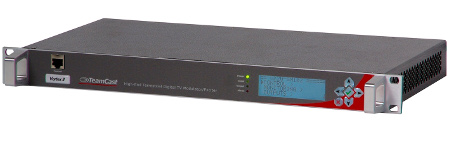Second-Gen 3.0 Exciter, Software ‘Critical’ In Next-Gen TV Testing
CLEVELAND—A TeamCast Vortex II exciter with new software supporting advanced ATSC 3.0 configuration profiles has been integrated into a Hitachi Kokusai Electric Comark TV transmitter at Tribune Media’s WJW for the next-gen TV testing station being conducted by NAB and the Consumer Technology Association (CTA), the company announced today.

The FCC has extended the experimental broadcast license under which WJW conducted two phases of testing—one focused on ATSC 3.0 performance in the VHF band and the second on UHF performance. The next testing round made possible by the extension will see the implementation of a completed, advanced real-world head-end system and tests of advanced next-gen TV configuration profiles and modes, including Multiple Physical Lay Pipers (Multi-PLP), Multiple Sub-Frames (time division multiplexing) and Layered Division Multiplexing (LDM), TeamCast said in a press release.
“With the recent announcement of the release of the ATSC 3.0 suite of standards at CES 2018, ATSC 3.0 is now real, and these field tests we are sponsoring with the Consumer Technology Association aim to demonstrate that ATSC 3.0 meets broadcasters’ expectations as being the most advanced service platform,” said NAB SVP Technology Lynn Claudy in the release.
Use of the TeamCast exciter, which is the second generation of the company’s DualCast ATSC 1.0/3.0 rack exciter, is “critical to successfully evaluating the capabilities” of the technology needed to support the next-gen broadcast standard, he added.
For a comprehensive list of TV Technology’s ATSC 3.0 coverage, see our ATSC3 silo.
Get the TV Tech Newsletter
The professional video industry's #1 source for news, trends and product and tech information. Sign up below.
Phil Kurz is a contributing editor to TV Tech. He has written about TV and video technology for more than 30 years and served as editor of three leading industry magazines. He earned a Bachelor of Journalism and a Master’s Degree in Journalism from the University of Missouri-Columbia School of Journalism.

